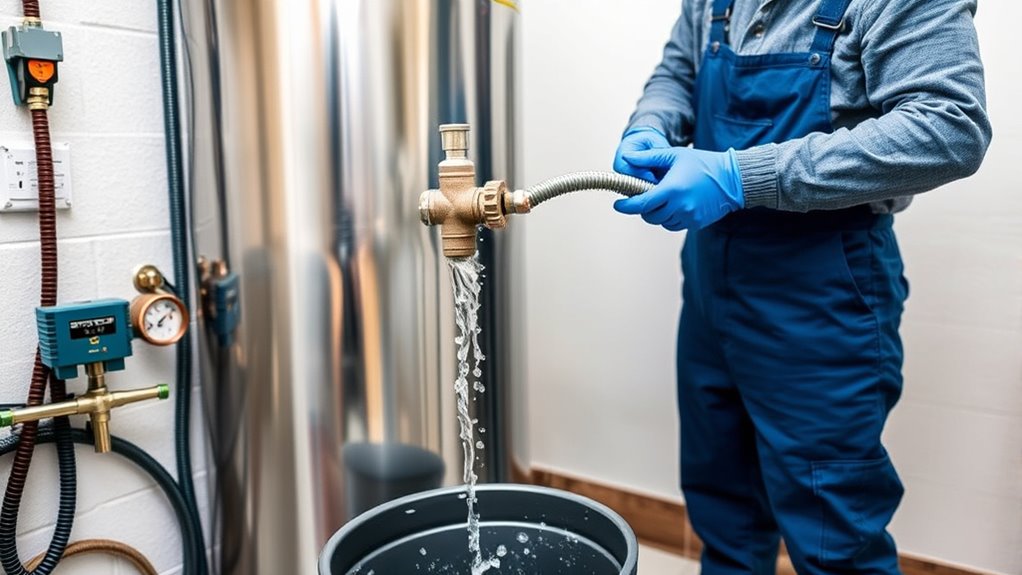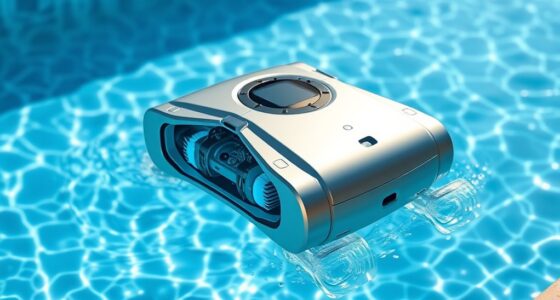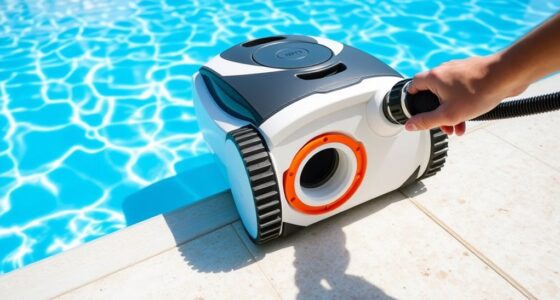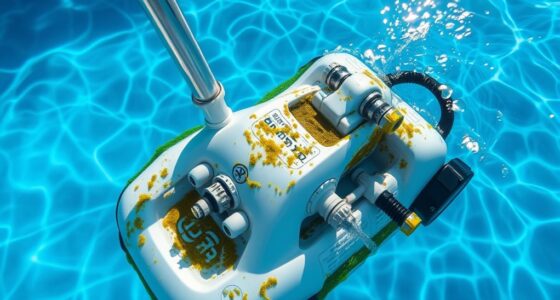To flush your water heater, turn off the power or gas, then shut off the cold water supply. Attach a garden hose to the drain valve and drain the tank completely, opening and closing the valve carefully. Briefly turn on cold water to rinse out sediment, then refill the tank and restore power. Regular maintenance keeps your heater running efficiently and prevents issues—continue exploring for detailed tips on caring for your drain valve and ensuring long-term performance.
Key Takeaways
- Turn off power and cold water supply, then attach a garden hose to the drain valve at the tank’s bottom.
- Open the drain valve to empty water and sediment from the tank.
- Briefly turn on cold water to flush remaining debris, then drain until water runs clear.
- Refill the tank by turning on cold water, then run hot water to clear air bubbles.
- Turn the power back on, check for leaks, and ensure the heater operates properly.
Water Heater Flushing and Drain Valve Care

Regularly flushing your water heater is essential to keep it running efficiently and extend its lifespan. Over time, sediment buildup accumulates at the bottom of the tank, which can hinder heat transfer and cause your heater to work harder. This not only wastes energy but also increases the risk of damage. One of the most straightforward ways to combat this issue is by performing a water heater flush. Maintaining the drain valve is a crucial part of this process, as it allows you to safely and effectively drain the tank without causing leaks or damage.
Regular flushing and drain valve maintenance keep your water heater efficient and extend its lifespan.
Before you start, turn off the power supply to your water heater, whether it’s electric or gas. This step is vital to prevent any accidents or damage to the heating elements. Next, shut off the cold water supply line to stop fresh water from entering the tank. Attach a garden hose to the drain valve located near the bottom of the tank. Make sure the other end of the hose is in a safe drainage area, such as a floor drain or outside, to handle the hot water safely. Opening the drain valve allows water to start flowing out of the tank, carrying sediment and debris with it.
As the tank drains, you might notice some resistance or slow flow, which is normal if sediment has built up around the valve or inside the tank. This is a good time to inspect the drain valve for any signs of corrosion or leaks. Proper drain valve maintenance is essential because a faulty valve can cause leaks or make future flushing difficult. If the valve seems stuck or corroded, consider replacing it to ensure smooth operation in the future. Once the tank is emptied, you can briefly turn on the cold water supply to flush out any remaining sediment, then drain again until the water runs clear.
After draining, close the drain valve tightly to prevent leaks. Remove the hose and turn the cold water supply back on, allowing the tank to fill completely. It’s a good idea to run hot water from a faucet to help force out any remaining debris and air bubbles. Once the tank is full and the hot water flows steadily, you can turn the power back on. Regular flushing combined with drain valve maintenance ensures your water heater stays clean and efficient, reducing energy costs and prolonging its service life. Remember, performing this task every year or as recommended by your manufacturer keeps sediment buildup at bay and helps your heater operate smoothly for years to come.
Frequently Asked Questions
How Often Should I Flush My Water Heater?
You should flush your water heater about once a year to prevent sediment buildup and maintain efficiency. Adjusting temperature settings to around 120°F helps reduce sediment accumulation and scald risks. If you notice reduced hot water flow or strange noises, it’s a sign you need a flush sooner. Regular flushing keeps your heater working efficiently, extends its lifespan, and guarantees safe, consistent hot water supply.
Can I Flush My Water Heater Myself?
Yes, you can flush your water heater yourself if you follow proper maintenance tips and safety precautions. Make sure to turn off the power or gas supply first, then shut off the cold water inlet. Wear protective gloves and eyewear, and carefully drain the tank to remove sediment buildup. Regular maintenance helps extend your heater’s lifespan, but always prioritize safety to avoid accidents or damage.
What Tools Are Needed for Flushing?
Imagine gathering your plumbing tools like wrenches and hoses, ready to tackle the task. You’ll need basic plumbing tools such as a pipe wrench, screwdrivers, and a garden hose to connect to the drain valve. Don’t forget safety equipment like gloves and goggles to protect yourself. These tools help you safely open, drain, and flush your water heater, ensuring smooth operation and preventing mineral buildup.
How Do I Prevent Future Sediment Buildup?
To prevent future sediment buildup, focus on improving water quality and practicing sediment prevention techniques. Install a sediment filter or water softener to reduce minerals and debris entering your water heater. Regularly check and maintain these filters, and consider flushing your tank annually to remove accumulated sediment. Additionally, lowering the water heater temperature can slow sediment formation, ensuring your system stays efficient and prolongs its lifespan.
What Are Signs My Water Heater Needs Flushing?
You might notice signs your water heater needs flushing if you see sediment accumulation in your hot water or experience inconsistent temperature fluctuations. Sediment buildup can cause your heater to work harder, making it less efficient and leading to uneven heating. Also, strange noises or a decrease in hot water supply could indicate the need for a flush. Addressing these signs promptly helps maintain your heater’s performance and longevity.
Conclusion
Regularly flushing your water heater is like giving it a gentle wake-up call, ensuring it runs efficiently for years to come. By caring for the drain valve and staying on top of maintenance, you’re preventing buildup and costly repairs. Think of it as tending to a garden—consistent care keeps everything flourishing. So, take a little time now; your hot water supply will thank you with warm comfort whenever you need it.









